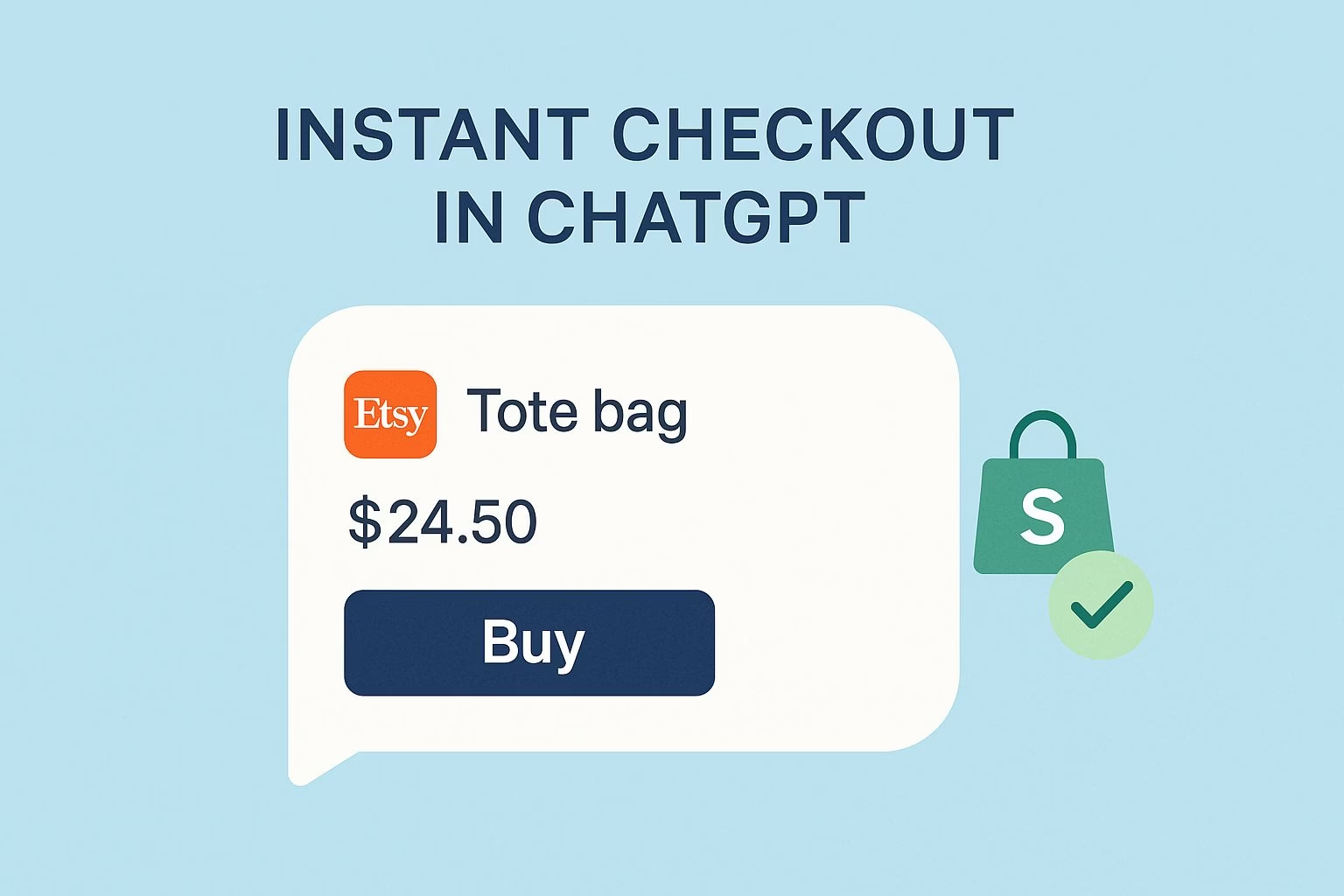OpenAI introduces direct purchasing in ChatGPT with Instant Checkout
- Users in the U.S. can buy inside ChatGPT with a simple Buy flow.
- Built with Stripe, starting with Etsy and expanding to Shopify.
- Powered by the open-source Agentic Commerce Protocol.
- Rankings stay organic based on relevance, not paid placement.
- Merchants get fewer drop-offs and a new channel with minimal setup.
OpenAI just launched a major step into AI-driven shopping with its new Instant Checkout feature. For the first time, users in the U.S. can complete purchases directly inside ChatGPT without leaving the chat.
Instead of being redirected to a store, you can click a “Buy” button, review the details, and finish the payment right in the conversation.
This new feature is built in partnership with Stripe, one of the biggest names in online payments. It starts with Etsy sellers, but support for over one million Shopify merchants is coming soon.
That means ChatGPT could quickly turn into a central shopping hub where millions of products are available in a natural conversation.
What makes this even more interesting is the open-source foundation. OpenAI released the Agentic Commerce Protocol (ACP), a system that any retailer can integrate with minimal setup if they already use Stripe.
This lowers the barrier for small and large merchants to tap into conversational commerce without rebuilding their entire checkout system.
For OpenAI, Instant Checkout creates a fresh revenue stream since they collect fees from completed sales. Product suggestions stay organic, ranked by relevance, not payment.
Still, the big question is whether ads will eventually make their way into the flow.
For now, it feels like the start of a new chapter in how we shop and interact with AI.
How does Instant Checkout work in ChatGPT
Instant Checkout is built to make shopping feel like part of a normal conversation. When ChatGPT suggests a product, a “Buy” button appears next to it.
Once clicked, you see a simple review page with the item, seller details, and price. From there, payment is processed through Stripe without leaving the chat.
The current rollout focuses on Etsy sellers. This gives the feature a wide variety of products right away, from handmade crafts to unique digital items.
Shopify integration is next, opening the door to over one million merchants. That scale could shift a large part of online shopping into AI-driven chats.
One of the most important details is how frictionless it is. Many online checkouts lose customers because of multiple page loads, forms, and redirects.
By keeping the process inside ChatGPT, OpenAI is betting that fewer people will abandon their carts. If that proves true, merchants could see higher conversion rates just by enabling ACP.
This setup also means ChatGPT becomes more than a chat assistant. It turns into a shopping interface where product discovery, conversation, and payment all happen in one flow.
That’s a big change compared to how e-commerce works today.
What is the Agentic Commerce Protocol
The Agentic Commerce Protocol (ACP) is the system that powers this feature. OpenAI didn’t keep it closed. Instead, they open-sourced it, making it available to any retailer who wants to integrate direct purchasing into conversations.
If you already sell through Stripe, ACP requires only minimal code changes. That makes it accessible even for small online shops that don’t have big development teams.
It reduces technical hurdles and allows merchants to start selling inside ChatGPT without a large investment.
Because ACP is open, it’s not limited to ChatGPT. Other AI agents, chat platforms, or even voice assistants could adopt it.
This creates a path for conversational commerce to spread beyond a single app. OpenAI’s decision to open-source ACP signals that they want it to become a standard protocol across AI-powered shopping.
For retailers, the protocol offers a future-proof way to be part of this shift.
As more users interact with AI agents instead of websites, ACP could become a core tool for staying competitive in digital commerce.
Why this move matters for merchants
For merchants, the introduction of Instant Checkout could change the way sales are made online.
Small sellers on Etsy or Shopify often struggle with abandoned carts when buyers drop off during checkout. By keeping the purchase inside ChatGPT, there are fewer steps and fewer chances for a buyer to leave before paying. That alone could raise conversion rates significantly.
Another advantage is reach. ChatGPT already has millions of users, many of whom use it daily for tasks and recommendations.
When products appear naturally in these conversations, sellers get direct visibility without extra marketing costs.
Since OpenAI has made it clear that product rankings stay organic, merchants don’t need to worry about being pushed down by larger competitors paying for placement.
There’s also flexibility in how ACP is structured. Sellers can still manage their inventory and customer relationships while tapping into a new sales channel.
It’s not meant to replace online stores but to add another layer where buyers can act instantly when they discover something they want. For small businesses, this can mean more consistent sales with less effort.
Over time, as ChatGPT expands to support more marketplaces, the potential customer base grows even larger.
That gives merchants an incentive to adopt ACP early and benefit from the first wave of AI-driven commerce.
What this means for OpenAI
For OpenAI, Instant Checkout is both a product update and a business shift. Until now, ChatGPT has been mainly a tool with subscription revenue.
With ACP and direct purchasing, the company is building a new stream of income by collecting fees from completed sales. This ties its growth more closely to the success of merchants on the platform.
There’s also the strategic side. If ChatGPT becomes a trusted shopping channel, OpenAI strengthens its position against big players like Amazon or Google Shopping.
Instead of users searching and comparing across multiple websites, purchases can happen during a single AI conversation. That changes user behavior in a way that benefits OpenAI directly.
Still, there are open questions. Will OpenAI eventually introduce ads into product recommendations?
For now, the promise is that results stay relevance-based, but monetization pressure often shifts these models over time.
The current structure avoids pay-to-play rankings, which helps maintain user trust.
Long term, this move signals that OpenAI wants ChatGPT to evolve into more than a productivity tool. It’s positioning the AI as a central hub for work, creativity, and now commerce.
Each of those streams can fuel revenue while keeping users inside the ecosystem.
| Feature | Traditional checkout | Instant Checkout in ChatGPT |
|---|---|---|
| Steps to purchase | Multiple pages, forms, redirects | One flow inside chat |
| Cart abandonment | Higher due to friction | Lower with no page switching |
| Merchant setup | Varies and can be complex | Simple for Stripe via ACP |
| Product discovery | Search engines, ads, marketplaces | Conversation in ChatGPT |
| Ranking model | Often influenced by ads | Relevance-based, organic |
Could this reshape online shopping
The shift to in-chat purchasing could change how people shop online. Instead of browsing dozens of websites, users might rely on AI to suggest products, answer questions, and complete the checkout in one place.
This is faster, easier, and more conversational than traditional e-commerce.
For buyers, this feels more natural. You can ask ChatGPT for recommendations, compare options in plain language, and then buy without leaving the chat.
It saves time and removes distractions like ads, popups, or unnecessary clicks. Over time, this experience may become the default way people expect to shop online.
For sellers, it levels the field. Big marketplaces like Amazon currently dominate because of scale and convenience.
Instant Checkout offers smaller retailers a chance to compete on the same ground, where what matters most is how relevant a product is to a user’s request, not how much ad money is behind it.
If ACP spreads to other AI platforms, we could see a wave of conversational commerce that makes websites less central to shopping.
That would be a fundamental shift in how both merchants and customers think about transactions.

